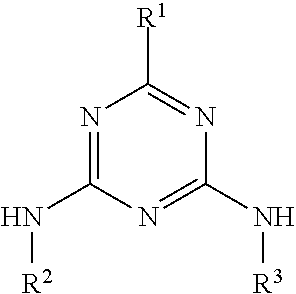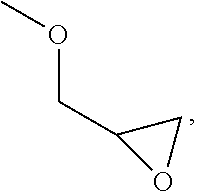Molecular Glasses With Functionalizable Groups
a functional group and molecular glass technology, applied in the field of molecular glasses, can solve the problems of limited glassy phase accessibility, unable to introduce a general glass-inducing moiety, and their tendency to crystalliz
- Summary
- Abstract
- Description
- Claims
- Application Information
AI Technical Summary
Problems solved by technology
Method used
Image
Examples
examples
1. Synthesis of 2-mexylamino-4-methylamino-6-chloro-1,3,5-triazine (Method A)
[0122]
[0123]2-Methylamino-4,6-dichloro-1,3,5-triazine (18.9 g, 105 mmol) was dissolved in acetone (150 mL) in a round-bottomed flask equipped with a magnetic stirrer. The flask was placed in an ice bath to keep temperature inside the flask under 5° C., then a solution of 3,5-dimethylaniline (13.2 mL, 12.8 g, 105 mmol) in acetone (50 mL) was added dropwise to the mixture. The ice bath was removed once the addition was complete, then the mixture was stirred at r.t. for an additional 30 min, at which point the mixture was poured in H2O (500 mL), and stirring was continued for 20 min until precipitation was completed. The precipitate was collected by filtration, then the crude product was triturated in hot toluene, filtered and allowed to dry completely to afford 19.2 g pure title compound (72.8 mmol, 69%); Tm 231° C.; FTIR (CH2Cl2 / KBr) 3264, 3196, 3123, 3007, 2914, 2848, 1634, 1615, 1587, 1542, 1453, 1391, 137...
PUM
| Property | Measurement | Unit |
|---|---|---|
| temperature | aaaaa | aaaaa |
| Tg | aaaaa | aaaaa |
| Tg | aaaaa | aaaaa |
Abstract
Description
Claims
Application Information
 Login to View More
Login to View More - Generate Ideas
- Intellectual Property
- Life Sciences
- Materials
- Tech Scout
- Unparalleled Data Quality
- Higher Quality Content
- 60% Fewer Hallucinations
Browse by: Latest US Patents, China's latest patents, Technical Efficacy Thesaurus, Application Domain, Technology Topic, Popular Technical Reports.
© 2025 PatSnap. All rights reserved.Legal|Privacy policy|Modern Slavery Act Transparency Statement|Sitemap|About US| Contact US: help@patsnap.com



